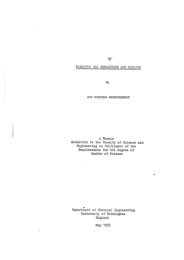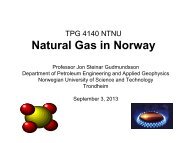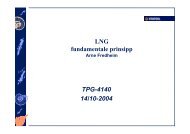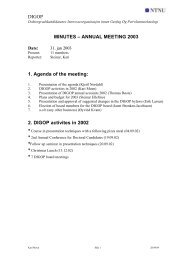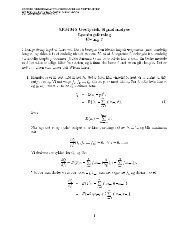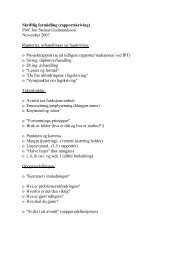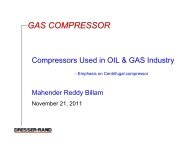Slug Catchers in Natural Gas Production - NTNU
Slug Catchers in Natural Gas Production - NTNU
Slug Catchers in Natural Gas Production - NTNU
You also want an ePaper? Increase the reach of your titles
YUMPU automatically turns print PDFs into web optimized ePapers that Google loves.
Karam – <strong>Slug</strong> <strong>Catchers</strong> <strong>in</strong> <strong>Natural</strong> <strong>Gas</strong> <strong>Production</strong><br />
10- Repeat<strong>in</strong>g the volume calculations after f<strong>in</strong>alization of all dimensions<br />
4.2 Close-up on the formulas beh<strong>in</strong>d the design<br />
<strong>Slug</strong> flow behavior must be determ<strong>in</strong>ed first <strong>in</strong> order to be able to design and size a slug catcher<br />
whether it is a normal slug flow or <strong>in</strong>duced by pigg<strong>in</strong>g. A number of calculations and a set of<br />
equations should be available and used. The slug length, slug holdup, slug velocity and translational<br />
velocity should all be determ<strong>in</strong>ed accord<strong>in</strong>g to Sarica et al. (1990). The slug velocity can be def<strong>in</strong>ed as<br />
the velocity of the mixture <strong>in</strong> steady state flow whereas the translational velocity, , is determ<strong>in</strong>ed by<br />
the equation below:<br />
(1)<br />
where is the velocity of the mixture, is the drift velocity and c is a constant. The drift velocity,<br />
which is the velocity of one phase relative to a surface mov<strong>in</strong>g at the mixture velocity, is expressed<br />
- for normal slug flow <strong>in</strong> vertical pipes, as:<br />
√<br />
(2.a)<br />
- for normal slug flow <strong>in</strong> horizontal pipes, as:<br />
√<br />
(2.b)<br />
- for normal slug flow <strong>in</strong> <strong>in</strong>cl<strong>in</strong>ed pipes based on the Bendiksen correlation (1984), as:<br />
(2.c)<br />
- for pigg<strong>in</strong>g, as:<br />
The constant c depends on the flow type thus if the flow is lam<strong>in</strong>ar, c=2. If the flow is turbulent, then<br />
c=1.2. Otherwise, the Taitel correlation (2000) is used; it is represented as follows,<br />
(2.d)<br />
( ) ( )<br />
(3)<br />
Page 12 of 56



